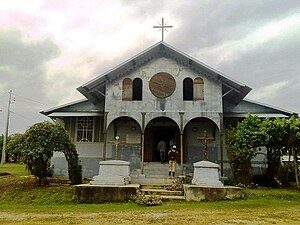| Donguila | |
|---|---|
| Village | |
 | |
 | |
| Coordinates: 0°13′N 9°45′E / 0.217°N 9.750°E / 0.217; 9.750 | |
| Country | |
| Province | Estuaire Province |
| Department | Komo-Mondah Department |
| Population | |
| • Total | 600 |
| Time zone | UTC+1 (WAT) |
Donguila (also Dongila; or Douglas) is a coastal village in Estuaire Province in northwestern Gabon. It lies along the L106 road (Nzamlique-Donguila road), 16 kilometres by road south of Nzamaligué. Donguila is best known for St. Paul Catholic mission founded in 1878, opposite the Pointe Denis. The general population speaks the Mekeh variant of the Fanghish language. Though found in several neighboring countries, the main type locality of the rodent, Peters's Hybomys, is Donguila.
History
Education was part of the social activities of missionaries. At Donguila, there was a school for boys, another for girls, and a vocational school for "apprentices." Young boys were given an essentially moral and religious instruction; secondarily they learned to read and write French. The girls were given an introduction to housework, sewing and embroidery. Léon M'ba originated from the Fang clans who attended the Donguila's Libreville mission schools. The French Roman Catholic archbishop, Marcel Lefebvre, served at the mission station from 1940-1943. Today, the Mission of St. Paul and its primary school continue to receive young Gabonese.
While exploring Gabon, the English writer and explorer Mary Kingsley, is known to have moored her boat at Donguila. In the early 1970s, Félix Houphouët-Boigny persuaded his protégé, Omar Bongo, to give Donguila farm (plantation) to Bob Denard. In the 1980s, Donguila and three other remote villages with populations of 1000-1500, Bougandji, Nyali, and Bolossoville, were selected as solar energy test sites, each receiving PV-powered public service systems. Jean Obame was the village chief in the 2000s.
Geography and climate

The village of Donguila is located on the right bank of the Komo River. The north bank, from the Ikoi River to Dongila is fronted by large banks of sand, rocks, and mud, while the land is elevated, and covered with trees and vegetation. The village is situated about 12 miles (19 km) eastward of the island, Île Coniquet, and 67.4 kilometres (41.9 mi) by road southeast of Libreville. It is a within the rural area of the Gabon Estuary. Surprise Rocks lie in the middle of the entrance to Komo River, about 2.5 miles (4.0 km) from Dongila.
Mangrove swamp forms a significant part of the surrounding landscape. Donguila consists of many small villages, the most important are Nyantsobe, Mbol Ezok, Saint Henri Le Four à Chaud (Aufourachaud), Mekome, and Edzoung Alenga. Approximately 6,000 square feet (560 m) in size, the Plantation Donguila is part of the Catholic Mission Donguila; it is also located on the right bank of the estuary at the entrance of the Komo River.
The climate is equatorial, hot and humid characterized by the alternation of four seasons: the short rainy season (mid-September, mid-December) the short dry season (mid-December, late January), the long rainy season (late January-mid May), and the long dry season (mid May-mid September).
Notable people
- Léon M'ba (1902–1967), first Prime Minister (1959–1961) and President (1961–1967) of Gabon
- Paul Biyoghé Mba (b. 1953), Prime Minister of Gabon (2009–2012)
- Simone Saint-Dénis (1930-2008), trade union leader taught at the Catholic School in the 1950s.
References
- Academy of Natural Sciences of Philadelphia (1933). Proceedings of the Academy of Natural Sciences of Philadelphia. Academy of Natural Sciences of Philadelphia. p. 409. Retrieved 1 April 2012.
- United States. Hydrographic Office (1908). West coast of Africa: Cape Palmas to the Cape of Good Hope and the adjacent islands (Public domain ed.). Government Printing Office. pp. 262–. Retrieved 1 April 2012.
- ^ Maps (Map). Google Maps.
- Auzias, Dominique; Voisin, Bernadette; Labourdette, Jean-Paul (30 September 2009). Gabon. Petit Futé. p. 149. ISBN 978-2-7469-2537-3. Retrieved 30 March 2012.
- N'Nah, Nicolas Métégué (2006). Histoire du Gabon: des origines à l'aube du XXIe siècle. L'Harmattan. p. 103. ISBN 978-2-296-01175-5. Retrieved 30 March 2012.
- Mintsa, Joe (December 2007). What Is Wrong with Black People? - How Post-Slave Psychology and Afrocentricity Are Joining with Colonialism to Undermine Black Africa's Cultural Inte. Lulu.com. pp. 541–. ISBN 978-1-84799-323-6. Retrieved 1 April 2012.
- Wilson, Don E. (2005). Mammal Species of the World: A Taxonomic and Geographic Reference. JHU Press. pp. 1332–. ISBN 978-0-8018-8221-0. Retrieved 1 April 2012.
- ^ Committee on African Studies in Canada; JSTOR (2004). Journal canadien des études africaines. Canadian Association of African Studies. p. 65. Retrieved 1 April 2012.
- ^ Callahan, Kevin J.; Curtis, Sarah Ann (2008). Views from the margins: creating identities in modern France. University of Nebraska Press. pp. 60, 83–. ISBN 978-0-8032-1559-7. Retrieved 1 April 2012.
- Alexander, Caroline (20 January 1990). One dry season: in the footsteps of Mary Kingsley. Knopf. p. 254. ISBN 978-0-394-57455-4. Retrieved 1 April 2012.
- Mockler, Anthony (1987). The new mercenaries. Paragon House. ISBN 978-0-913729-72-4. Retrieved 1 April 2012.
- American Solar Energy Society. Meeting; International Solar Energy Society. American Section (1983). Proceedings of the ... Annual Meeting, American Solar Energy Society, Inc. American Solar Energy Society. p. 582. Retrieved 1 April 2012.
- United States. Hydrographic Office (1916). Africa Pilot: comprises the sailing directions of the southwest coast of Africa from Cape Palmas to the Cape of Good Hope, including the islands of St. Helen, Ascension, Tristan da Cunha, and neighboring islands (Public domain ed.). Government Printing Office. p. 274. Retrieved 1 April 2012.
- Miwa, Masanao (1985). Retroviruses in human lymphoma/leukemia: proceedings of the 15th International Symposium of the Princess Takamatsu Cancer Research Fund, Tokyo, 1984. Japan Scientific Societies Press. p. 110. ISBN 978-4-7622-9453-2. Retrieved 30 March 2012.
- Jardin colonial France; France. Ministère des colonies. Inspection générale de l'agriculture coloniale (1904). L'Agriculture pratique des pays chauds (in French) (Public domain ed.). p. 303. Retrieved 1 April 2012.